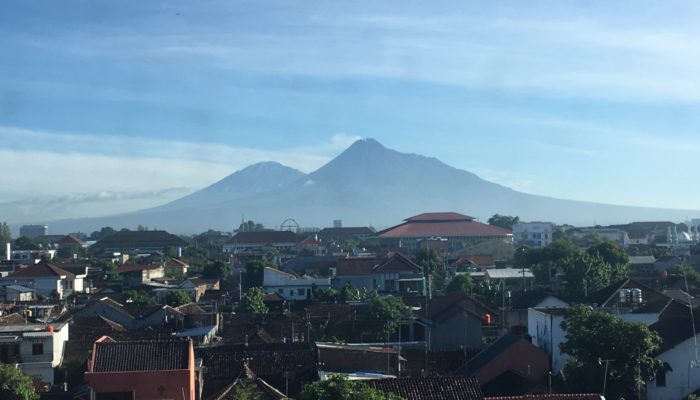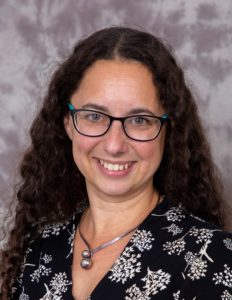
In today’s interview, we talk with Prof. Claire J. Horwell. Claire has been awarded the 2020 Plinius Medal for her outstanding interdisciplinary research on the respiratory health implications of inhaling volcanic emissions, and other particulates.
my research focuses on protecting communities from exposures to potentially harmful airborne particulates
Hi Claire, can you please briefly introduce yourself?

Claire J. Horwell
Hello! I’m a Professor of Geohealth at Durham University, UK, in the Department of Earth Sciences and Institute of Hazard, Risk & Resilience. I am Director of the International Volcanic Health Hazard Network (IVHHN, www.ivhhn.org) and I’m also currently the President of the AGU’s GeoHealth Section. I have been at Durham for 13 years. Before that, I was a NERC Fellow at the University of Cambridge, UK. My undergraduate degree was in Environmental Science (at UEA, UK) and I have a Diploma in Volcanology (MSc equiv.) from Victoria University of Wellington, NZ and a PhD in Volcanology from the University of Bristol, UK, where I studied with Steve Sparks, one of the highest recognized scientists in the field of volcanology.
You have been awarded the 2020 Plinius Medal, which particularly recognises interdisciplinary research in natural hazards. First of all: congratulations! Can you tell us more about your field of research? And how does interdisciplinarity help?
Thanks! Twenty years into my academic career, I can summarize my research focus as being about protecting communities from exposures to potentially harmful airborne particulates. Those nine words encapsulate a plethora of disciplines, knowledge of which are essential in order to answer the critical research questions. Starting at the end of the phrase: are particles harmful? The early years of my career focused on the geochemical and petrological analysis of volcanic ash, and the magma/lava from which it derived, to understand the characteristics which might influence toxicity, and collaboration with toxicologists to then test whether the particles could cause adverse reactions in cells. I especially focused on the mineral crystalline silica and that also led me to study other natural and industrial dust (e.g. coal, desert, diatomaceous earth, combusted sugarcane).
The next part of the phrase is ‘exposure’; communities are only at risk of harm if they are exposed to a pathogen. So, my research has required air quality monitoring expertise and working directly with communities to understand their ability to cope with exposures. The latter led me to work with anthropologists, sociologists, and behavioural psychologists, and to start to conduct social research myself.
Finally, ‘protection’: early on in my career, I thought that the big research question was ‘is this dust harmful to inhale?’ so, as well as the fundamental geochemistry/toxicology work, my group also worked to develop rapid techniques for assessment of the respiratory health hazard of ash during eruption crises. But, around five years ago, once I started actually working with communities and practitioners, it became clear that another question was equally important, in the timeframe of the eruption crisis: ‘how can I protect myself’? This led to a large project, working with PPE (personal protective equipment) specialists to determine the effectiveness of different forms of respiratory protection worn by communities in volcanic environments, globally. In turn, that led to a collaboration with a health lawyer/bioethicist to consider the legal and ethical challenges for agencies recommending interventions for communities, the efficacy of which may not be supported by scientific evidence. As you can imagine, that work has come in useful during the current COVID-19 crisis! So, to answer critical questions at the intersection of society, public health and earth sciences, the only approach is an interdisciplinary one!
to answer critical questions at the intersection of society, public health and earth sciences, the only approach is an interdisciplinary one!
What are the main concerns regarding respiratory health and volcanic aerosols?
The main concern is that inhaling volcanic particles, gases or aerosols could either exacerbate pre-existing diseases or even trigger new diseases. If exposure is short, healthy people may not particularly suffer from inhaling volcanic emissions. They may have an irritated upper respiratory system (cough, sneezing, sore/itchy throat, and nose) but nothing more serious. Asthmatics (and people with other respiratory diseases) can react badly to even short exposures (especially to sulphur dioxide gas) and experience a worsening of their normal symptoms such as wheeze or shortness of breath.
If exposure is prolonged, because volcanic emissions continue for many months/years or there is a lot of resuspension of ash by wind etc., the concern is that the exposures may cause disease. To date, we still don’t know if this is possible. There haven’t been sufficient long-term studies to be sure.
The mineral of greatest concern in volcanic ash is crystalline silica, and only some types of eruption produce quartz or cristobalite (the main polymorphs). In industrial exposures to mineral dust, workers may develop fatal diseases such as silicosis or lung cancer, which is why we are so concerned, but we still don’t know if volcanic silica can cause these diseases despite the longest (fictitious!) word in the English language describing this disease: pneumonoultramicroscopicsilicovolcanoconiosis!
It is also now well-established that small particles (i.e. ‘PM2.5’), in general, are involved in a range of chronic diseases, especially in urban settings. Again, it is too early to know whether volcanic particles can be considered to be similarly pathogenic. There is much research to be done!
Claire has also recently taken part on an episode of ‘Volcano Moments’ hosted by Dr Janine Krippner on her YouTube channel. They talked about volcanic ash health hazards, check it out by clicking here.
As often happens in the broad field of natural hazards, one of the main difficulties is to deal with the perception of the risk. Is volcanic aerosol generally perceived as a health threat?
In our research, we have found that perceptions of hazard and risk are very dependent on individual communities and the level of information and education that they have received. Sometimes, the information, itself, can be poorly-informed leading to misconceptions about the risk. An example of this is in Indonesia, where we found that local volunteers for disaster management agencies were telling communities that volcanic ash was highly corrosive and abrasive in the lungs, so people should protect themselves. They would demonstrate this by taking ash and rubbing it on their scooters and showing the damaged paintwork. In fact, at the minuscule sizes of particles which can be inhaled (<100 µm diameter), the ash is not sharp. That is a common misconception. It cannot cut your lungs and it is not abrasive, although it may have an acidic surface. Our research has also shown, however, that sulphate salts on ash surfaces don’t trigger a toxic reaction in cells. In all likelihood, the salts dissolve, and acidity is buffered by the fluids which coat our lungs.

Street children clean ash off a car in Yogyakarta, Indonesia following the 2014 Kelud eruption. Photo credit: Tri Wahyudi
You are also an active tweeter and source of useful information regarding health protection during and after volcanic eruptions and in general volcanic and geo-hazards. I think we can say that you have a positive attitude towards scientists being active on Social Media. What is, for you, a pro and a con of being on Social Media as a scientist?
As Director of IVHHN, a huge pro of being on social media is that I can use it as a conduit to disseminate the various informational products that we have produced on the health hazards of, and protection from, volcanic emissions. Over the past three years, we have produced a range of printable and audio-visual products (downloadable from www.ivhhn.org) in many different languages. We have a new pamphlet available on the health hazards of volcanic and geothermal gases, downloadable here! I will use social media to advertise that and ask for volunteers to translate the new pamphlet into different languages. If you are reading and are interested in helping to translate the pamphlet get in touch!
Social media has also been an incredible networking resource for me. I use Twitter to contact and communicate with practitioners, agencies, journalists, activists and the public during eruptions and other air pollution crises. In terms of negative aspects, it has taken me a lot of time and effort to build up a sufficient following that my posts are going to be seen. Also, there are times where comments can be less than supportive … I tend to block those people! Life is too short to get upset by these things, but I’d rather not hear from them again!

jensen designed
Woah! I’m really enjoying the template/theme of this
site. It’s simple, yet effective. A lot of times it’s very hard to get that “perfect balance”
between superb usability and appearance. I must say that you’ve done a great job with this.
Additionally, the blog loads extremely quick for me on Safari.
Outstanding Blog!